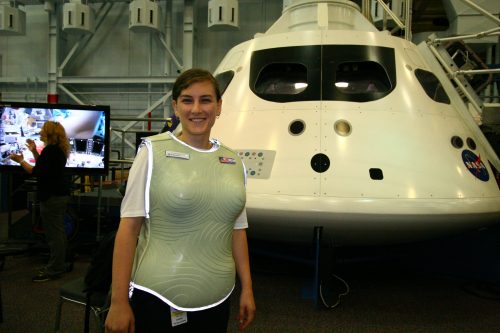The suit was developed by Dr. Oren Milstein during his doctoral thesis at the Weizmann Institute following the Fukushima disaster. He founded the start-up company StemRad which developed a special belt that protects the hip pelvis containing half of the bone marrow in a person and is currently widely used among "first responders" in Israel and around the world. Now, as mentioned, it will also undergo an experiment in space conditions

The Israeli Space Agency in the Ministry of Science signed an agreement last night, January 31, with the German Center for Space Research to launch an innovative Israeli development into space. The agreement was signed as part of the Israeli Space Week events, and its purpose is to launch on the next test flight of the "Orion" spacecraft an innovative radiation protection suit developed by an Israeli company. The agreement is signed by the Director of the Israel Space Agency at the Ministry of Science Avi Blasberger andCEO of the German Space Agency Dr. Pascal Ehrenfreund as Director General of the Peretz and Zahn Ministry of Science.
Minister of Science Ofir Akunis He said about the agreement: "Israeli technologies in the field of space are known for their innovation and thinking outside the box. We are proud to break new ground and integrate into one of the most fascinating human experiments in the coming years."
The beginning of the story on a white night that Dr Oren Milstein After the Fukushima nuclear reactor disaster. The knowledge he gained during his PhD in immunology at the Weizmann Institute of Science gave him no rest and led him to think of a solution that could save people exposed to extreme radiation. A few months after the disaster, Dr. Milstein founded the start-up company StemRad, which developed a special belt that protects the hip pelvis, which contains half of the bone marrow in a person. The belt is currently widely used among "first responders" in Israel and around the world.
"High-intensity ionizing radiation destroys bone marrow, which is the body's blood-making plant, and causes severe anemia, infections and cancer," says Dr. Milstein. "Studies have shown that it is enough to protect 5% of the bone marrow to bring about cell renewal and recovery."
Based on the same principle of the belt, the company is currently developing, together with Lockheed Martin, a more advanced suit that will protect against cosmic radiation in space. The suit is expected to be launched on the first test flight of the "Orion" spacecraft currently being built by NASA and which will be launched in 2018 to the moon. The flight, Exploration Mission 1, is considered critical preparation for the next Orion flights that will be manned and take astronauts to Mars.
The journey to Mars is considered particularly long and during it the future astronauts will be exposed to a lot of radiation, especially during solar flares. In "Orion" there is a small area where the astronauts can hide during the eruption, but this is an impractical solution since the eruption can last even a week. That way, when the astronauts in the spaceship or on Mars receive a warning about a solar flare, they will be able to put on the suit and continue their normal function.

The suit developed by StemRad is based on the principle of selective protection of bone marrow and the lungs, chest, stomach, colon and ovaries, which are particularly sensitive to the formation of cancer due to exposure to radiation. The suit is made of hydrogen-rich materials and is worn like a vest on the upper body. Since women are particularly sensitive to radiation, the suit was first adapted to women. Since on such a long journey into space every gram is significant, the company found a solution to recycle the packaging materials in the spacecraft, such as the plastics used to pack the food, for the benefit of the suit. By melting the packages, discs of compressed plastic are formed which can be stuck on the body of the suit. The plastic contains hydrogen which has ideal properties for stopping ionic particles.
As part of the test flight in 2018, the effects of radiation in deep space and the extent of its absorption in the human body will be tested for the first time. The German Space Agency (DLR), under the German Space Research Center, will use a "Matroshka", a blood corpse containing thousands of radiation detectors, which will be launched as part of the flight wearing a suit developed by the Israeli company, alongside a "Matroshka" without a suit. About a month later, when the spacecraft returns to Earth, the team will be able to examine the level of radiation absorbed by it and its effectiveness and make adjustments to the suit as required. The ambition is that the suit will be included as standard in the manned Exploration Mission 2 planned for 2021 and the future journey to Mars.
The research group, where along with Dr. Milstein, Dr Gideon Waterman and Tamar Nix, has already visited the spacecraft construction facilities at NASA and presented the suit. Among the company's consultants as well Isaac Mayo, who was the intended replacement of Ilan Ramon and at the time was training to be an astronaut at NASA facilities. As part of the company's accompanying consultants, you can also find three Nobel Prize winners - Prof. Michael Levitt, Prof. Aharon Chachanover and Prof. Roger Kornberg.
